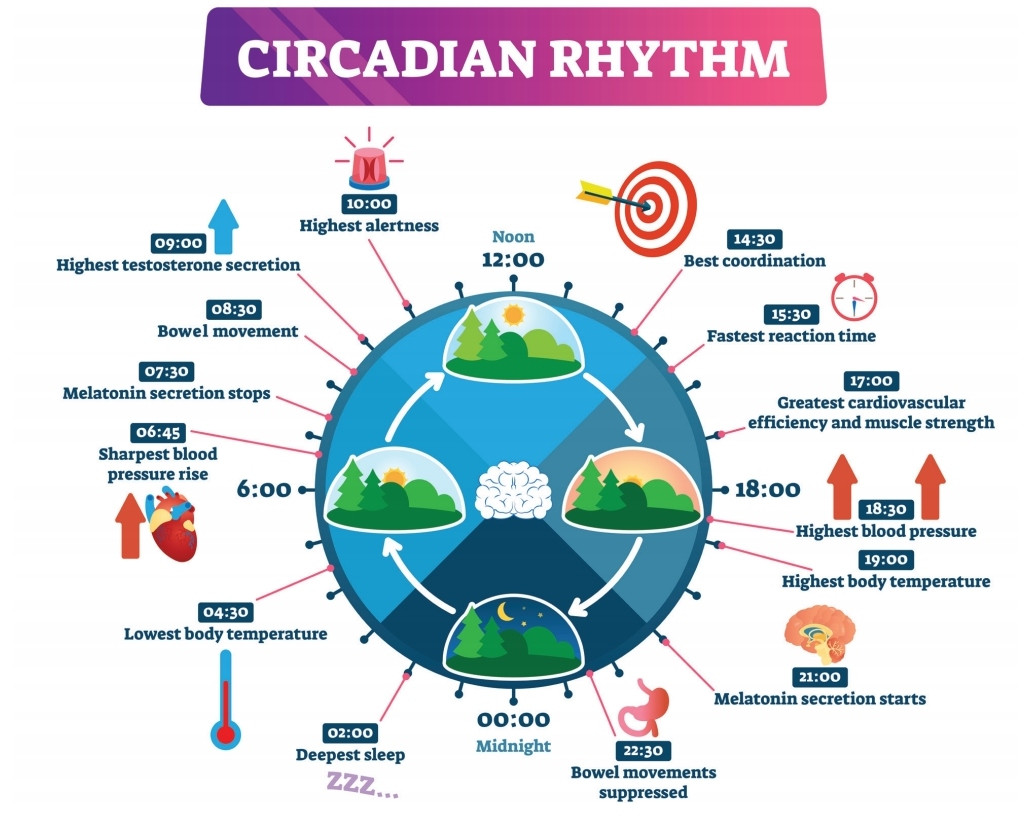Circadian rhythm is an important aspect of human physiology and has a significant impact on health and well-being. The term “circadian” comes from the Latin words for “around” (circa) and “day” (dies). The circadian rhythm is a 24-hour cycle that governs many aspects of human physiology, including body temperature, hormone levels, metabolism, and sleep patterns.
The circadian rhythm is controlled by an internal biological clock that responds to light cues from the environment. The main cue that resets the clock each day is sunlight. The light exposure causes a signal to be sent to the suprachiasmatic nucleus (SCN), which is located in the hypothalamus. This signal triggers a cascade of events that reset the body’s clocks throughout the brain and peripheral nervous system.
The SCN receives input from two types of photoreceptors: rods and cones. Rods are responsible for vision in low light conditions, while cones are responsible for color vision. Both types of photoreceptors send signals to the SCN via different pathways. Rods send signals directly to the SCN, while cones send signals indirectly via other neurons in the retina known as ganglion cells.
Once the SCN receives input from rods and cones, it sends out output signals that affect various physiological processes throughout the body. These output signals can be divided into two categories: direct effects and indirect effects. Direct effects are those that occur when output signals from the SCN directly influence target cells or tissues; indirect effects are those that occur when output signals from the SCN influence intermediary cells or tissues, which then go on to influence other cells or tissues downstream.
One example of a direct effect is how output signals from the SCN affect melatonin production by pineal gland cells. Melatonin is a hormone involved in regulating sleep patterns; its levels rise at night and fall during daylight hours. Output signals from the SCN cause pineal gland cells to increase melatonin production at night, which makes people feel sleepy; during daylight hours, these same output signals decrease melatonin production, making people feel more awake and alert. Other examples of direct effects include changes in heart rate, blood pressure, hormone release by endocrine glands, and digestion rates .
An example of an indirect effect would be howoutputsignalsfromtheSCNin fluence eating behaviors . Theseoutputsignals do not directly target hunger -related hormonesorbrain regionsinvolvedin hungerand satiety ; instead , they targetsleep -promotingneurons inthe ventrolateral preoptic area( VLPOA ). When these neuronsareactivated , theysend inhibitorysignals tonetworksof neuronsinvolvedin feedingbehavior ; this ultimately leads towakingup feeling lesshungry .
In additionto playinga role insleep regulation ,the circadianrhythm also affects metabolism , immune function , cognitive performance ,emotional state ,and pain perception . For instance , research showsthat individuals tend towake up feeling more hungry on dayswhen they have slept lessthan usual ; this increasedhungeris likely dueto disruptionsin metabolism causedby lackof sleep . Additionally , studieshave shownthat shift workerswho work at night tendto have poorerimmune functionthan those whowork duringthe day ; this maybe duebecausenighttime workershave reducedexposureto naturallight , which disruptstheir circadianrhythmsand decreasesproductionof vitamin D . Furthermore , recentstudieshave suggesteda link betweencognitive declineand alterationsin circadianrhythmicity ; specifically , olderadults with greater variabilityin their dailywake -upshowedpoorerperformanceon tests assessingepisodicmemory thanthose withmore consistentwaketimes . Finally , bothclinicalobservationsand animal modelssuggestthatthe circadianrhythm playsa role infeelingsof depressionand anxiety :for example ,” morning larks ” who naturallyget upearlytendtohave lowerratesof depressionthan” night owls ” whonaturallystayupextendedperiodsof time


